Above all, and this is quite curious, the painting of Toulouse Lautrec greatly interested him, was it once more because Lautrec too had a literary side.
The thing that I want to insist upon is that Picasso’s gift is completely the gift of a painter and a draughtsman, he is a man who always has need of emptying himself, of completely emptying himself, it is necessary that he should be greatly stimulated so that he could be active enough to empty himself completely.
This was always the way he lived his life.
After this first definite French influence he became once more completely Spanish. Very soon the Spanish temperament was again very real inside in him. He went back again to Spain in 1902 and the painting known as his blue period was the result of that return.
The sadness of Spain and the monotony of the Spanish coloring, after the time spent in Paris, struck him forcibly upon his return there. Because one must never forget that Spain is not like other southern countries, it is not colorful, all the colors in Spain are white black silver or gold, there is no red or green, not at all. Spain in this sense is not at all southern, it is oriental, women there wear black more often than colors, the earth is dry and gold in color, the sky is blue almost black, the star-light nights are black too or a very dark blue and the air is very light, so that every one and everything is black. All the same I like Spain. Everything that was Spanish impressed itself upon Picasso when he returned there after his second absence and the result is what is known as his blue period. The French influence which had made his first or Toulouse Lautrec one was over and he had returned to his real character, his Spanish character.
Then again in 1904 he was once again in Paris.
He lived in Montmartre, in the rue Ravignan, its name has been changed now, but the last time I was there it still had its old charm, the little square was just as it was the first time I saw it, a carpenter was working in a corner, the children were there, the houses were all about the same as they had been, the old atelier building where all of them had lived was still standing, perhaps since then, for it is two or three years that I was there last, perhaps now they have commenced to tear it all down and build another building. It is normal to build new buildings but all the same one does not like anything to change and the rue Ravignan of that time was really something, it was the rue Ravignan and it was there that many things that were important in the history of twentieth century art happened.
Anyway Picasso had once more returned to Paris and it was around 1904 and he brought back with him the pictures of the blue period, also a little landscape of this period which he had painted in Barcelona. Once more back in Paris he commenced again to be a little French, that is he was again seduced by France, there was his intimacy with Guillaume Apollinaire and Max Jacob and André Salmon and they were constantly seeing each other, and this once again relieved his Spanish solemnity and so once more, needing to completely empty himself of everything he had, he emptied himself of the blue period, of the renewal of the Spanish spirit and that over he commenced painting what is now called the rose or harlequin period.
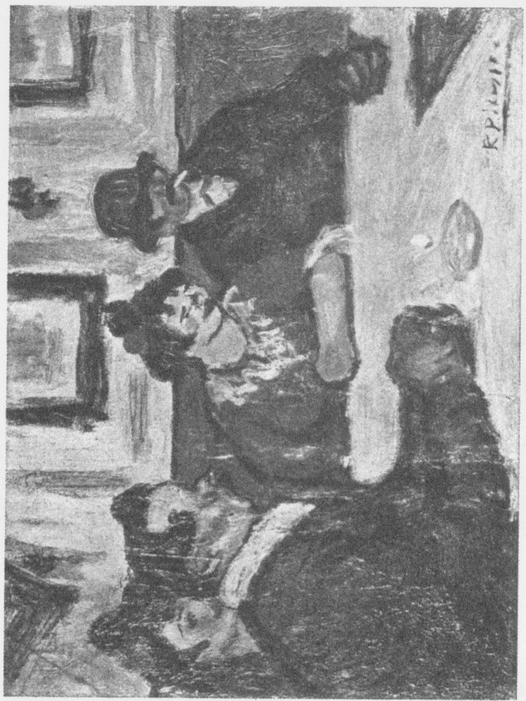
5 IN THE CAFE: Toulouse-Lautrec Period (1901)
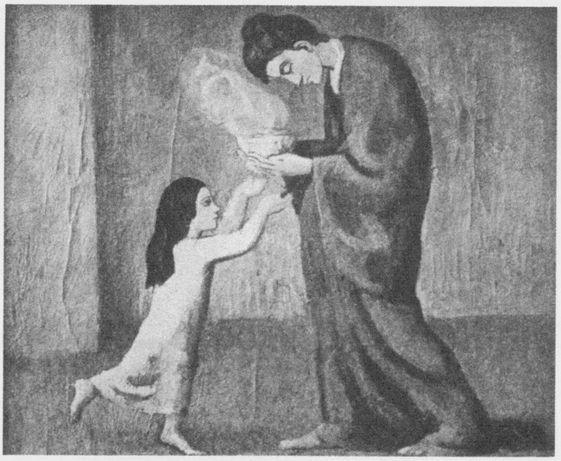
6 MOTHER AND CHILD : Blue Period (Summer. 1902)
Painters have always liked the circus, even now when the circus is replaced by the cinema and night clubs, they like to remember the clowns and acrobats of the circus.
At this time they all met at least once a week at the Cirque Medrano and there they felt very flattered because they could be intimate with the clowns, the jugglers, the horses and their riders. Picasso little by little was more and more French and this started the rose or harlequin period. Then he emptied himself of this, the gentle poetry of France and the circus, he emptied himself of them in the same way that he had emptied himself of the blue period and I first knew him at the end of this harlequin period.
The first picture we had of his is, if you like, rose or harlequin, it is The Young Girl With a Basket of Flowers, it was painted at the great moment of the harlequin period, full of grace and delicacy and charm. After that little by little his drawing hardened, his line became firmer, his color more vigorous, naturally he was no longer a boy he was a man, and then in 1905 he painted my portrait.
Why did he wish to have a model before him just at this time, this I really do not know, but everything pushed him to it, he was completely emptied of the inspiration of the harlequin period, being Spanish commenced again to be active inside in him and I being an American, and in a kind of a way America and Spain have something in common, perhaps for all these reasons he wished me to pose for him. We met at Sagot’s, the picture dealer, from whom we had bought The Girl with a Basket of Flowers. I posed for him all that winter, eighty times and in the end he painted out the head, he told me that he could not look at me any more and then he left once more for Spain. It was the first time since the blue period and immediately upon his return from Spain he painted in the head without having seen me again and he gave me the picture and I was and I still am satisfied with my portrait, for me, it is I, and it is the only reproduction of me which is always I, for me.
A funny story.
One day a rich collector came to my house and he looked at the portrait and he wanted to know how much I had paid for it. Nothing I said to him, nothing he cried out, nothing I answered, naturally he gave it to me. Some days after I told this to Picasso, he smiled, he doesn’t understand, he said, that at that time the difference between a sale and a gift was negligible.
Once again Picasso in 1909 was in Spain and he brought back with him some landscapes which were, certainly were, the beginning of cubism. These three landscapes were extraordinarily realistic and all the same the beginning of cubism. Picasso had by chance taken some photographs of the village that he had painted and it always amused me when every one protested against the fantasy of the pictures to make them look at the photographs which made them see that the pictures were almost exactly like the photographs. Oscar Wilde used to say that nature did nothing but copy art and really there is some truth in this and certainly the Spanish villages were as cubistic as these paintings.
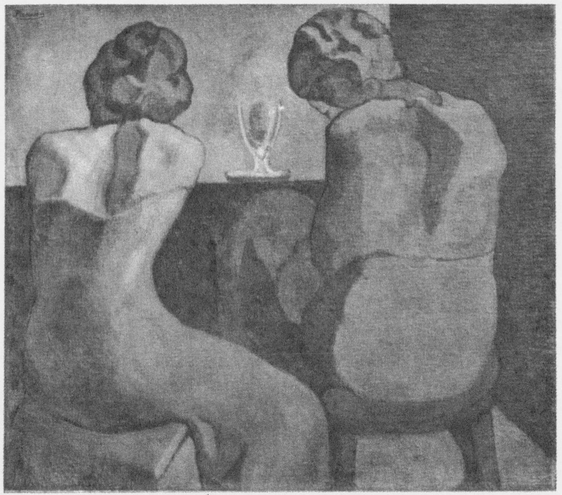
7 WOMEN AT A BAR: Blue Period (1902)
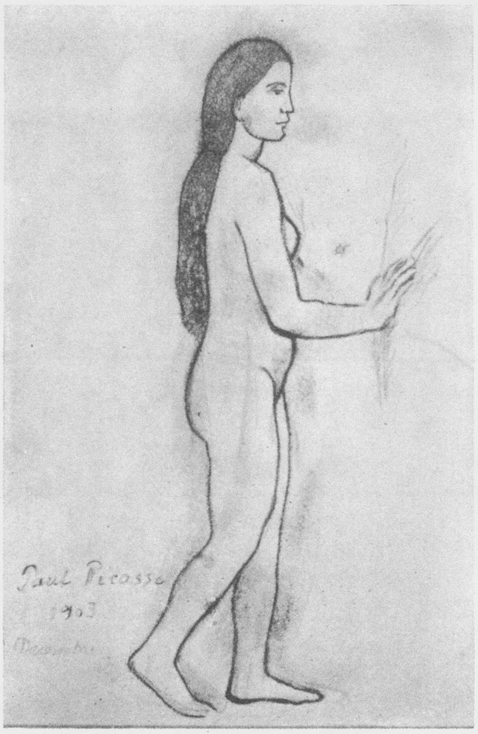
8 NUDE : Charcoal Drawing (1903)
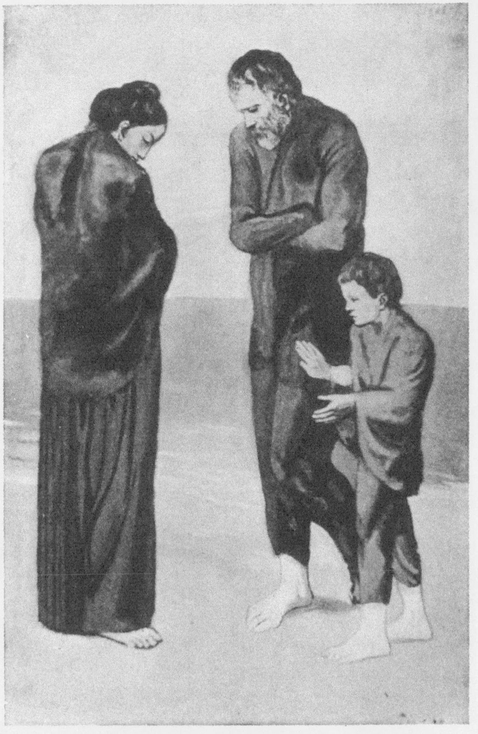
9 LES PAUVRES AU BORD DE LA MER:
Blue Period (Summer, 1903)
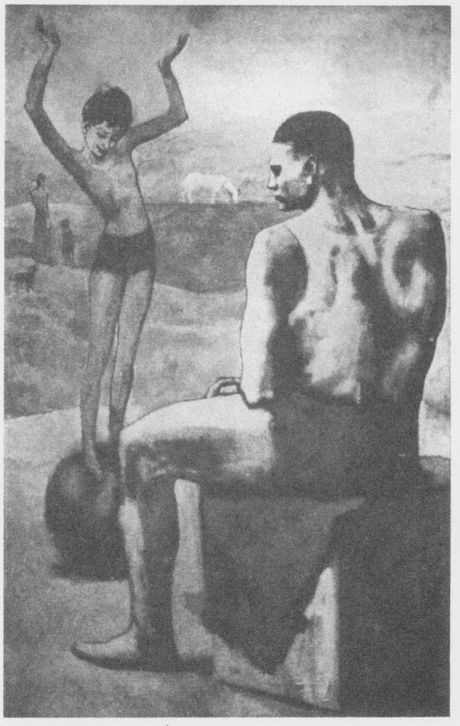
10 LA FILLETTE SUR LA BOULE:
Rose Period (Autumn, 1904)
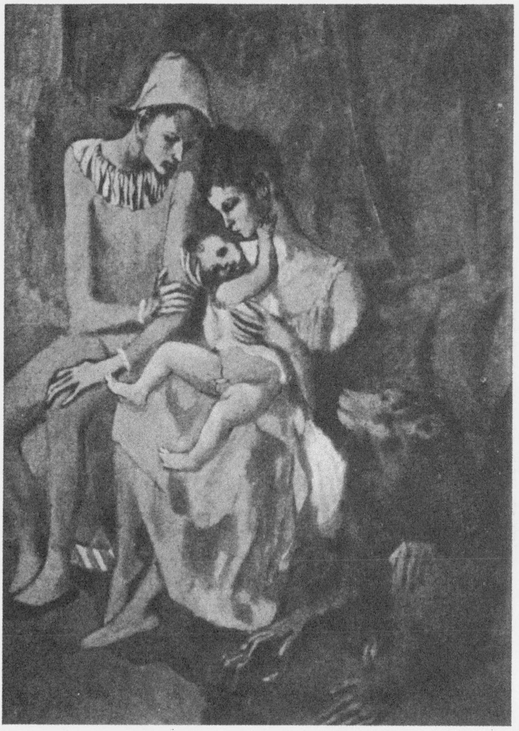
11 LA FAMILLE D’ARLEQUIN AU SINGE :
Rose Period (Spring, 1905)
So Picasso was once more baptised Spanish.
Then commenced the long period which Max Jacob has called the Heroic Age of Cubism, and it was an heroic age. All ages are heroic, that is to say there are heroes in all ages who do things because they cannot do otherwise and neither they nor the others understand how and why these things happen. One does not ever understand, before they are completely created, what is happening and one does not at all understand what one has done until the moment when it is all done. Picasso said once that he who created a thing is forced to make it ugly. In the effort to create the intensity and the struggle to create this intensity, the result always produces a certain ugliness, those who follow can make of this thing a beautiful thing because they know what they are doing, the thing having already been invented, but the inventor because he does not know what he is going to invent inevitably the thing he makes must have its ugliness.
At this period 1908–1909, Picasso had almost never exhibited his pictures, his followers showed theirs but he did not. He said that when one went to an exhibition and looked at the pictures of the other painters one knows that they are bad, there is no excuse for it they are simply bad, but one’s own pictures, one knows the reasons why they are bad and so they are not hopelessly bad. At this time he liked to say and later too he used to repeat it, there are so few people who understand and later when every one admires you there are still the same few who understand, just as few as before.
So then Picasso came back from Spain, 1908, with his landscapes that were the beginning of cubism. To really create cubism he had still a long way to go but a beginning had been made.
One can say that cubism has a triple foundation. First.
1 comment